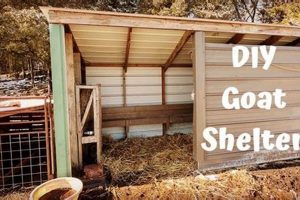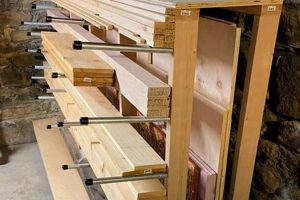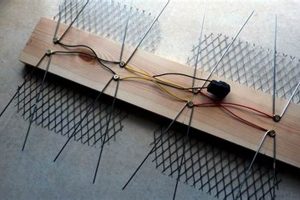The creation of a support structure for climbing plants, utilizing moss as a medium for aerial root attachment, allows for enhanced vertical growth. These structures provide a humid environment conducive to the development of adventitious roots, mimicking the plant’s natural habitat. An example includes constructing a cylindrical frame around a wooden stake, then packing the frame with moistened sphagnum moss.
This type of support offers several advantages. It encourages larger leaf development in certain species, as the plant dedicates less energy to searching for support. Furthermore, the constant moisture provided by the moss can reduce the need for frequent watering of the plant’s soil. Historically, similar supports have been used in greenhouses and conservatories to cultivate tropical climbing plants, demonstrating an understanding of the relationship between humidity, root development, and plant vigor.
Subsequent discussion will focus on detailed construction methods, alternative materials, and maintenance strategies for these plant supports, ensuring their longevity and effectiveness in promoting optimal plant health.
Enhancing Plant Growth Through Moss Supports
The following guidelines are designed to optimize the effectiveness and longevity of vertical plant supports created with moss, ensuring they contribute positively to plant health and aesthetic appeal.
Tip 1: Material Selection: Prioritize sphagnum moss for its superior water retention and aeration properties. Avoid using garden soil or other organic matter prone to decomposition, as this can lead to anaerobic conditions detrimental to root health.
Tip 2: Structural Integrity: Employ durable materials for the frame, such as PVC pipe or treated wood, to withstand the weight of the plant and the moisture from the moss. Securely fasten all components to prevent collapse.
Tip 3: Moisture Management: Regularly mist the moss to maintain consistent moisture levels. Avoid oversaturation, which can promote fungal growth. Observe the plant for signs of dehydration or overwatering and adjust accordingly.
Tip 4: Gradual Adaptation: Introduce plants to the support gradually. Do not force aerial roots into the moss. Allow the plant to naturally attach as it grows, which minimizes stress and promotes healthy root development.
Tip 5: Pest Control: Inspect the moss and plant regularly for pests. Implement appropriate pest control measures, such as insecticidal soap or beneficial insects, to prevent infestations.
Tip 6: Nutritional Support: Supplement the plant’s nutritional needs with diluted liquid fertilizer, applied directly to the moss. This provides essential nutrients to the aerial roots, enhancing growth and vigor.
Tip 7: Regular Maintenance: Periodically inspect the support for damage or deterioration. Replace the moss as needed to maintain its structural integrity and moisture-retaining properties. Prune any dead or decaying foliage to prevent disease.
Adherence to these guidelines will maximize the benefits of moss supports, fostering robust plant growth and creating visually appealing botanical displays. Consistent care and maintenance are crucial for long-term success.
The subsequent section will address advanced techniques, including customizing supports for specific plant species and troubleshooting common issues that may arise during their use.
1. Support
The structural integrity of a plant support, especially when constructed using moss, directly influences its ability to foster healthy growth. The provision of adequate support, achieved through a well-constructed frame and secure fastening, prevents structural collapse under the weight of the plant. This, in turn, ensures continued access to the moisture and nutrients retained within the moss medium. For example, a frame constructed from insufficiently durable materials, such as untreated softwood, is prone to rot and eventual failure, depriving the plant of necessary vertical support and access to aerial root hydration. The absence of robust support jeopardizes the plant’s stability, potentially leading to stem breakage or stunted growth, negating the intended benefits of the moss-based environment.
A properly engineered framework not only supports the plant’s weight but also maintains the shape and density of the moss column. This structural integrity is vital for uniform hydration and aeration. A deformed or compacted moss column restricts airflow to the aerial roots and creates pockets of anaerobic conditions, increasing the risk of root rot. Examples of robust frame construction include utilizing PVC piping or treated lumber arranged in a cylindrical or rectangular shape, secured with durable fasteners. These designs distribute the weight evenly and resist deformation, maximizing the longevity and effectiveness of the moss-based support.
Therefore, understanding the critical relationship between structural support and the success of the moss pole is paramount. Prioritizing durable materials and sound construction techniques mitigates the risk of structural failure, ensuring the plant receives consistent support and access to the humid microclimate essential for optimal aerial root development. The initial investment in quality materials and careful construction directly translates into enhanced plant health and longevity, validating the significance of robust support as a fundamental component of a moss based plant support.
2. Hydration
Hydration is a critical component in the functionality of a moss-based plant support. The consistent moisture level within the moss provides a humid microclimate essential for the development and maintenance of aerial roots. These roots, characteristic of many climbing plants, draw moisture and nutrients directly from the humid environment surrounding the support. Insufficient hydration leads to desiccation of these roots, hindering nutrient uptake and ultimately affecting the plant’s overall health and growth. Conversely, oversaturation can create anaerobic conditions, fostering fungal growth and root rot. Therefore, maintaining optimal hydration is paramount for a successful moss support.
The effectiveness of hydration strategies depends on several factors, including the type of moss used, the ambient humidity, and the plant’s specific water requirements. Sphagnum moss, for example, possesses superior water retention capabilities compared to other moss varieties. Implementing a regular misting schedule, adjusted based on environmental conditions, allows for controlled hydration. Real-world examples include adjusting misting frequency during drier months or utilizing self-watering mechanisms, such as internal reservoirs, to provide a consistent moisture supply. Furthermore, the physical characteristics of the support itself, such as the presence of drainage holes, influence the balance between moisture retention and the prevention of waterlogging. Monitoring the moss and plant regu
larly for signs of dehydration or overwatering is essential for adapting hydration strategies to meet the evolving needs of the plant.
Understanding the nuanced relationship between hydration and plant health within a moss support system presents both challenges and opportunities. While consistent moisture is crucial, achieving the optimal balance requires careful observation and adaptive management. Effective hydration strategies contribute significantly to the long-term success of vertical growing systems, promoting robust root development and enhanced plant vigor. Addressing hydration challenges through informed practices maximizes the benefits and overall aesthetic appeal of moss supports.
3. Material
The selection of materials for the construction of moss-based plant supports directly influences their structural integrity, longevity, and effectiveness in promoting plant health. The nature of the frame, the type of moss used, and the binding material all contribute to the overall performance of the support. For instance, a frame constructed from untreated wood will degrade more rapidly than one made from PVC or treated lumber, reducing the lifespan of the entire structure and potentially leading to its collapse. Similarly, the choice of moss affects water retention and aeration; sphagnum moss is generally preferred for its superior properties compared to other varieties. The materials’ properties, therefore, directly impact the success of the plant support system.
Practical applications of material selection involve considering the specific needs of the plant being supported. A heavier, more robust climbing plant necessitates a stronger frame and a more densely packed moss column. Conversely, a smaller, lighter plant may thrive with a more lightweight structure. Examples include using copper wire or fishing line to securely bind the moss to the frame, providing a non-degradable and aesthetically unobtrusive method of attachment. Furthermore, utilizing recycled materials, such as plastic bottles or repurposed lumber, contributes to environmentally sustainable gardening practices while still providing adequate support. Proper material choice allows customization of the structure to the species.
In summary, material selection represents a critical decision point in the creation of moss supports. The understanding of material properties, combined with the specific requirements of the supported plant, leads to a more effective and durable growing structure. Challenges include balancing cost considerations with the need for long-lasting, environmentally sound options. Nevertheless, a thoughtful approach to material selection is paramount for ensuring the sustained health and aesthetic appeal of plants grown using vertical support systems.
4. Anchorage
Anchorage, in the context of plant cultivation employing moss supports, refers to the methods by which a plant secures itself to the structure, enabling vertical growth. Effective anchorage is critical for maximizing the benefits of moss supports, facilitating nutrient uptake, and promoting overall plant health.
- Adventitious Root Development
Adventitious roots, which emerge along the stems of climbing plants, are the primary means of anchorage to a moss support. The moist environment provided by the moss encourages the formation of these roots, allowing the plant to firmly attach itself. Proper hydration of the moss column is crucial for stimulating adventitious root growth. The absence of such root development prevents the plant from effectively utilizing the support and accessing the nutrients available within the moss.
- Binding Techniques
In some instances, manual binding is necessary to initially secure the plant to the support. This can involve using soft, plant-safe materials such as twine or horticultural tape to gently attach the stems to the moss column. The binding should be loose enough to allow for natural growth and avoid restricting the plant’s development. As adventitious roots develop, the binding materials can be gradually removed, allowing the plant to independently anchor itself.
- Surface Texture
The surface texture of the moss column influences the ease with which plants can establish anchorage. A rougher surface, achieved by loosely packing the moss, provides more points of contact for adventitious roots to grasp. Conversely, a tightly packed, smooth surface may hinder root attachment. Consideration should be given to the specific texture preferences of the plant species being supported when constructing the moss column.
- Support Orientation
The orientation of the plant in relation to the support also impacts anchorage. Encouraging the plant to grow towards the moss column, rather than away from it, facilitates root attachment. This can be achieved by gently guiding the stems towards the support and providing adequate light to promote growth in that direction. Periodic adjustments may be necessary to ensure the plant maintains proper orientation.
These facets of anchorage highlight the importance of facilitating natural root attachment to ensure the long-term success. Careful consideration of these elements, combined with attentive monitoring and maintenance, optimizes plant growth and the intended functionality of the vertical support system.
5. Aeration
Aeration within a moss based plant support is critical for maintaining a healthy root environment and preventing anaerobic conditions. Inadequate airflow surrounding the aerial roots of plants growing on these supports can lead to the buildup of stagnant moisture, fostering the proliferation of anaerobic bacteria and fungi. This, in turn, increases the risk of root rot and other detrimental conditions that inhibit nutrient uptake and overall plant vigor. The structure of the moss column itself, along with its moisture content, directly impacts the level of aeration; densely packed, oversaturated moss restricts airflow, while loosely packed, moderately moist moss promotes it. A real-life example involves observing the root health of plants on supports constructed with differing moss densities; plants on the more aerated supports consistently exhibit healthier root systems compared to those on densely packed supports. Understanding the correlation between aeration and root health is, therefore, of paramount importance for the successful implementation of these vertical support systems.
Achieving optimal aeration involves several practical considerations. The choice of moss type plays a significant role, with coarser, less water-retentive moss varieties providing greater airflow. Furthermore, the construction technique employed in creating the moss column influences its porosity; layering the moss loosely and avoiding excessive compression promotes aeration. Regular maintenance practices, such as lightly fluffing the moss and ensuring adequate drainage, further enhance airflow. The ambient environment also affects aeration; plants kept in enclosed, humid spaces require more vigilant monitoring to prevent anaerobic conditions. By carefully considering these factors and implementing appropriate strategies, plant enthusiasts can mitigate the risks associated with inadequate aeration and promote robust root
development within moss-based plant supports.
In summary, aeration represents a crucial, yet often overlooked, component of moss supports. Ensuring sufficient airflow to the aerial roots not only prevents detrimental anaerobic conditions but also optimizes nutrient uptake and promotes overall plant health. Challenges lie in balancing moisture retention with the need for aeration, requiring careful monitoring and adaptive management. However, by prioritizing aeration in the design and maintenance of these vertical support systems, individuals can significantly enhance the growth and well-being of their plants.
6. Longevity
The durability of a moss-based plant support structure directly impacts its long-term effectiveness and economic value. The longevity of materials utilized in constructing supports determines how long it will continue to serve its intended purpose of providing moisture, anchorage, and structural support to climbing plants. Choosing rot-resistant materials, such as treated lumber or PVC piping for the frame, significantly extends the usable lifespan of the structure. This reduces the frequency of replacement and minimizes associated costs. For example, using untreated wood will lead to decomposition over time when consistently exposed to moisture from the moss, causing structural instability and necessitating frequent reconstruction. Careful material selection is paramount to establishing a foundation for prolonged usability.
Maintenance practices also greatly influence the lifespan of such structures. Regularly replacing or replenishing the moss as it degrades ensures consistent moisture retention and structural integrity. Implementing pest control measures prevents infestations that can damage both the moss and the frame. Proper irrigation techniques, avoiding oversaturation, minimize the risk of rot and fungal growth. An example would be regularly flushing the moss pole with water to remove mineral buildup from tap water, preventing the moss from becoming hardened and less effective. These proactive measures are essential to prolonging the period over which the diy structure provides optimal conditions for plant growth. Ignoring such maintenance will lead to diminished support, reduced plant health, and the need for premature replacement.
Ultimately, the longevity of the moss support is a synthesis of thoughtful material selection and diligent maintenance. While initial construction might require more effort and resources, a longer-lasting support offers sustainable benefits by reducing the need for frequent replacements and minimizing environmental impact. Challenges lie in balancing cost considerations with the long-term value of durable materials and consistent care. However, the extended lifespan of a well-constructed and maintained moss structure ensures consistent support and promotes healthy plant development over an extended period, validating its overall value.
Frequently Asked Questions About Plant Support Structures
The following questions address common inquiries regarding the construction, maintenance, and use of vertical plant supports employing moss as a primary medium.
Question 1: What is the optimal type of moss for use in plant supports?
Sphagnum moss is generally considered the optimal choice due to its high water retention capacity, excellent aeration properties, and resistance to decomposition compared to other moss varieties.
Question 2: How frequently should moss-based supports be watered?
Watering frequency depends on environmental conditions, plant species, and the density of the moss. Monitoring the moisture level of the moss and the plant’s overall hydration status is crucial for determining an appropriate watering schedule.
Question 3: What materials are suitable for constructing the frame of a moss support?
Durable, water-resistant materials such as PVC pipe, treated lumber, or metal mesh are recommended for constructing the frame, as these materials will withstand constant moisture exposure and support the weight of the plant.
Question 4: How can pest infestations within moss supports be prevented?
Regularly inspect the moss and the plant for signs of pests. Implement appropriate pest control measures, such as insecticidal soap or beneficial insects, to prevent infestations from establishing.
Question 5: Is fertilization necessary for plants growing on moss supports?
Supplemental fertilization is beneficial, particularly for plants with high nutrient demands. Diluted liquid fertilizer can be applied directly to the moss to provide essential nutrients to the aerial roots.
Question 6: How often should the moss be replaced within a support structure?
The moss should be replaced when it begins to decompose, loses its water retention capacity, or becomes excessively compacted. Typically, replacement is necessary every 1-2 years, depending on environmental conditions and maintenance practices.
These frequently asked questions offer clarity on crucial factors influencing effective use of plant supports. Knowledge and care are essential for maximizing plant growth.
The next section will address advanced customization techniques for specialized plants.
Conclusion
This article has explored the multifaceted aspects of the diy moss pole, encompassing construction techniques, material selection, maintenance strategies, and the underlying principles governing its effectiveness. From optimizing hydration and aeration to ensuring structural integrity and addressing potential pest infestations, comprehensive understanding dictates successful application. Emphasis has been placed on practical guidance, facilitating informed decision-making in creating and maintaining effective diy plant support systems.
Continued innovation and refinement of diy moss pole techniques are crucial for advancing plant cultivation practices. As understanding of plant physiology deepens, so too will the ability to tailor these structures to specific species’ needs, optimizing growth and enhancing aesthetic appeal. The diy moss pole represents a commitment to sustainable and informed gardening practices, offering a tangible means of fostering plant health and promoting environmental stewardship. Further exploration and implementation of these techniques will undoubtedly contribute to advancements in the field of plant cultivation.







